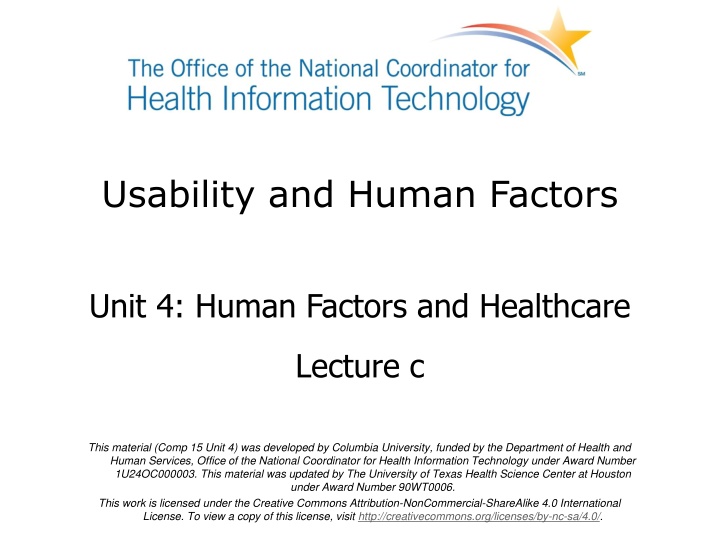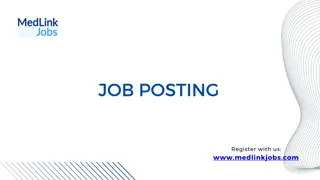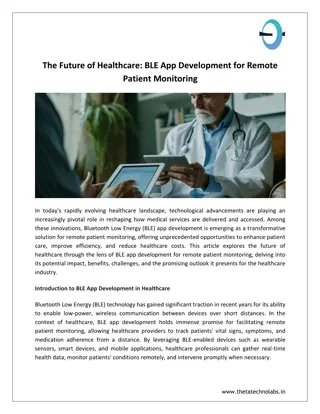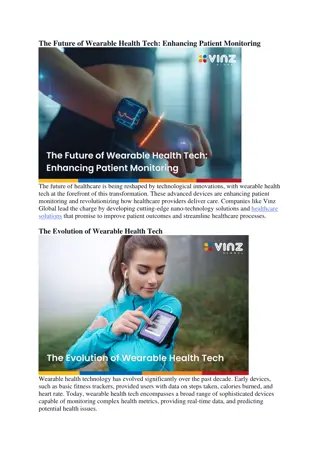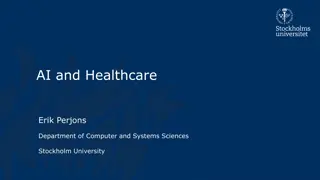Enhancing Human Factors in Healthcare
This material delves into the critical aspects of human factors and healthcare, covering topics such as human-computer interactions, cognitive ergonomics, mental workload, human error, and the impact of heavy nursing workload on patient safety. It provides valuable insights into how human factors engineering can improve usability, safety, and performance in healthcare settings.
Download Presentation

Please find below an Image/Link to download the presentation.
The content on the website is provided AS IS for your information and personal use only. It may not be sold, licensed, or shared on other websites without obtaining consent from the author.If you encounter any issues during the download, it is possible that the publisher has removed the file from their server.
You are allowed to download the files provided on this website for personal or commercial use, subject to the condition that they are used lawfully. All files are the property of their respective owners.
The content on the website is provided AS IS for your information and personal use only. It may not be sold, licensed, or shared on other websites without obtaining consent from the author.
E N D
Presentation Transcript
Usability and Human Factors Unit 4: Human Factors and Healthcare Lecture c This material (Comp 15 Unit 4) was developed by Columbia University, funded by the Department of Health and Human Services, Office of the National Coordinator for Health Information Technology under Award Number 1U24OC000003. This material was updated by The University of Texas Health Science Center at Houston under Award Number 90WT0006. This work is licensed under the Creative Commons Attribution-NonCommercial-ShareAlike 4.0 International License. To view a copy of this license, visit http://creativecommons.org/licenses/by-nc-sa/4.0/.
Human Factors and Healthcare Lecture c Learning Objectives Objective 1: Distinguish between human factors and human computer interactions (HCI) as they apply to usability (Lecture a) Objective 2: Explain how cognitive, physical and organization ergonomics can be applied to human factors engineering (Lecture a) Objective 3: Describe how the concepts of mental workload, selective attention and information overload affect usability (Lecture a) Objective 4: Describe the different dimensions of the concept of human error (Lecture b) 2
Human Factors and Healthcare Lecture c Learning Objectives (Cont d 1) Objective 5: Describe a systems-centered approach to error and patient safety (Lecture b) Objective 6: Apply methods for measuring mental workload and information overload (Lecture c) Objective 7: Describe how human factors analysis can be applied to the study of medical devices (Lecture c) 3
Effects of Heavy Nursing Workload Mechanisms Time Description Insufficient time to perform tasks safely, apply safe practices, or monitor patients, and may reduce their communication with physicians. Dissatisfied with job, thus affecting their motivation for high-quality performance. Stress and burnout, which can have a negative impact on their performance. Examples Little time to double- check medications Frustration and negative attitude toward job Reduced physical and cognitive resources to perform adequately Forgetting to administer medications A charge nurse may not be available to help other nurses with their patients when needed. Motivation Stress and burnout Contribute to errors, such as slips and lapses or mistakes. Could affect the safety of care provided by another nurse. Errors in decision making (attention) Systemic/organizatio nal impact 4.5 Table: (Carayon & G rses, 2005) 4
Mental Workload Multidimensional construct Task demands Expectations regarding the quality of performance Person effort Can vary across persons and situations Difficult to measure 5
NASA TLX: Task Load Index A multi-dimensional rating procedure Provides overall workload score based on a weighted average of ratings on 6 subscales: Mental demands Physical demands Temporal demands Own performance Effort Frustration 6
NASA TLX Index: Rating Scale Definitions MENTAL DEMAND: Low/High How much mental & perceptual activity was required (e.g., thinking, deciding, calculating, remembering, looking, searching, etc.)? Was the task easy or demanding, simple or complex, exacting or forgiving? PHYSICAL DEMAND: Low/High How much physical activity was required (e.g., pushing, pulling, turning, controlling, activating, etc.)? Was the task easy or demanding, slow or brisk, slack or strenuous, restful or laborious? TEMPORAL DEMAND Low/High How much time pressure did you feel due to the rate or pace at which the tasks or task elements occurred? Was the pace slow and leisurely or rapid and frantic?
NASA TLX Index: Rating Scale Definitions (Cont d 1) EFFORT: Low/High How hard did you have to work (mentally and physically) to accomplish your level of performance? PERFORMANCE: Good/Poor How successful do you think you were in accomplishing the goals of the task set by the experimenter (or yourself)? How satisfied were you with your performance in accomplishing these goals? FRUSTRATION LEVEL: Low/High How insecure, discouraged, irritated, stressed and annoyed versus secure, gratified, content, relaxed and complacent did you feel during the task?
Medical Devices Healthcare products, excluding drugs, which are used for human beings for the purpose of prevention, diagnosis, monitoring, treatment or alleviation of an illness Center for Devices and Radiological Health (CDRH), a division of the Food and Drug Administration (FDA) Common source of medical error Operator error (incorrectly entering a drug cartridge concentration) Patient error Mechanical problems 60% deaths & serious injuries attributed to operator error 9
Patient Controlled Analgesics Method of pain relief which uses disposable or electronic infusion devices and allows patients to self-administer analgesic drugs as required Patients determine when and how much medication they receive Used in millions of patients every year 10
Lin, Isla, Doniz et al (1998) Purpose: redesign a PCA user interface according to HF techniques and principles Improve efficiency and safety Cognitive task analysis was used to evaluate and redesign the system Experiment involving 12 student nurses programming the device 11
Cognitive Task Analysis (CTA) Widely used method in human factors Breaks a task into: sets of subtasks or steps system responses and inferences that are needed to interpret the state of the system. Effective measure for gauging the complexity of a system 12
Cognitive Task Analysis Findings Structure of many subtasks in programming sequence is unnecessarily complex No global view of decision process Lack of external representation of dialog structure No overview of how many parameters Order sequence Steps that have been completed and those that remain Misleading visual grouping of controls Limited amount of feedback on small screen 13
Redesign of Interface System structure simplified by minimizing the number of message display screens Choices presented in parallel rather than serially Lin, L., Isla, R., Doniz, K., Harkness, H., et al. (1998). 14
Experimental Evaluation Programming the new interface was 15% faster The average workload rating for the old interface was twice as high New interface led to 10 errors as compared to 20 for the old one Medical equipment can be made safer and more efficient by adopting human factors design principles 15
Mobile Health Devices Handheld devices used in healthcare context by clinician, patient or health consumer Tablets, smart phones (iPhones, Androids) and Blackberries ePocrates, LexiDrugs, Up-to-Date Mobile patient monitoring, Glucowatch, electronic health diaries, & advanced function glucose meters, FitBit, smart watches 16
Uses of Mobile Health Devices Improve information access Enhance workflow Communication Promote evidence-based decision making & empower patients Lack of a stable interaction paradigm, especially on patient side 17
Ultra Smart Meter Hierarchical menu Nonlinear/tangled Max depth of 5 levels/screens Breadth 2-8 (items on a single menu) Input: button press Kaufman, D.R. & Starren, J. B. (2006).
Hierarchical Menu Systems Flow of control between human and device Interactive style provides visible options to user Structure of system can be fairly transparent Constrained path of options May require minimal training Learning by exploring menu structure Breadth-depth tradeoffs 19
Objectives of Study Usability and learnability of LifeScan UltraSmart Identify aspects of device which facilitate or impede productive use Determine whether older adults could develop basic competency (learnability) o Autonomously perform or learn to perform the range of tasks through experience and/or reading the instructional materials Characterize prerequisite competencies, knowledge and skills o Robust Mental Model of System 20
Mental Models Mental representation of how things work Anticipate events Reason about outcomes Project backwards from event to explain Try to reconstruct episodes from memory Running of a model corresponds to a process of mental simulation Generate possible future states of system For example, If I click OK on this button, what will happen next? Temporal and spatial reasoning
Mental Model of Cell Phones Older adults had inferior mental models of phone menu than younger adults (Ziefle & Bay, 2004) Shallower notion of menu s depth Lack of understanding of hierarchical representation associated with poor performance Lack of a mental model can lead to disorientation in menu selection tasks Repeatedly open the same node Follow suboptimal paths Increase time to locate information 22
Glucose Meter Usability Evaluation Cognitive task analysis Performed by 3 coders Usability Testing with 5 older adults Repeatedly open the same node Follow suboptimal paths Increase time to locate information 23
Summary of Usability Testing All subjects experienced significant problems in the first session Data entry tasks Demonstrated degree of improvement in second session Highly variable Subjects exhibited trial and error Perseverated through fruitless searches Wrong place 24
Observed Problems Limited visibility of system state Inadequate prompts Not informative guiding subjects to next step Errors result from following the wrong path Error correction returning to prior state is nontrivial Confusing task-action mappings 25
Study Conclusions UltraSmart support self-management in patient with diabetes Steep learning curve, especially for older adults Most would experience difficulty in developing a sufficiently robust mental model to negotiate menu structure Taxing on Memory Difficult design problem Empirical testing can yield more effective design solutions offers wide range of resources to 26
Unit 4: Human Factors and Healthcare Summary Lecture c As new and novel technologies proliferate, human factors will play an increasingly larger role Workload is a complex construct that is measurable in a number of ways Important in understanding stresses and strains on human performance Dramatic growth of devices in healthcare require a new level of scrutiny Human factors methods and principles can positively influence design choices 27
Unit 4 Summary: Human Factors and Healthcare Growing importance of human factors in health and other domains Reason model of error Slips and mistakes Knowledge vs. rule-based mistakes Human factors methods and principles can positively influence design choices 28
Unit 4: Human Factors and Healthcare References Lecture c References Carayon, P., & G rses, A. P. (2005). A human factors engineering conceptual framework of nursing workload and patient safety in intensive care units. Intensive and Critical Care Nursing, 21(5), 284-301. Hart S.G. & Staveland L. E. (1988) Development of NASA-TLX (Task Load Index): Results of empirical and theoretical research. In Hancock P. A., Meshkati N. (Eds.)Human Mental Workload. Amsterdam: North Holland Press. Kaufman, D.R. & Starren, J. B. (2006). A methodological framework for evaluating mobile health devices. In the Proceedings of the American Medical Informatics Annual Fall Symposium. Philadelphia: Hanley & Belfus. 978 Lin, L., Isla, R., Doniz, K., Harkness, H., Vicente, K. J., & Doyle, D. J. (1998). Applying human factors to the design of medical equipment: patient-controlled analgesia. Journal of Clinical Monitoring & Computing, 14(4), 253-263. 29
Unit 4: Human Factors and Healthcare References Lecture c (Cont d 1) Images Slide 14: Lin, L., Isla, R., Doniz, K., Harkness, H., Vicente, K. J., & Doyle, D. J. (1998). Applying human factors to the design of medical equipment: patient-controlled analgesia. Journal of Clinical Monitoring & Computing, 14(4), 253-263. Slide 18: Kaufman, D.R. & Starren, J. B. (2006). A methodological framework for evaluating mobile health devices. In the Proceedings of the American Medical Informatics Annual Fall Symposium. Philadelphia: Hanley & Belfus. 978 Charts, Tables, & Figures 4.5 Table: Carayon, P., & G rses, A. P. (2005). A human factors engineering conceptual framework of nursing workload and patient safety in intensive care units. Intensive and Critical Care Nursing, 21(5), 284-301. 30
Unit 4: Human Factors and Healthcare Lecture c This material was developed by Columbia University, funded by the Department of Health and Human Services, Office of the National Coordinator for Health Information Technology under Award Number 1U24OC000003. This material was updated by The University of Texas Health Science Center at Houston under Award Number 90WT0006. 31
